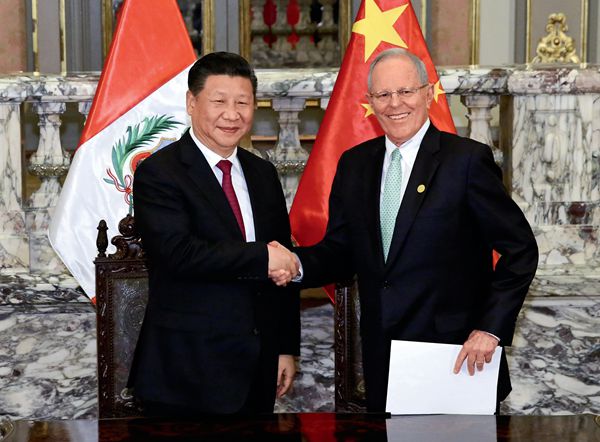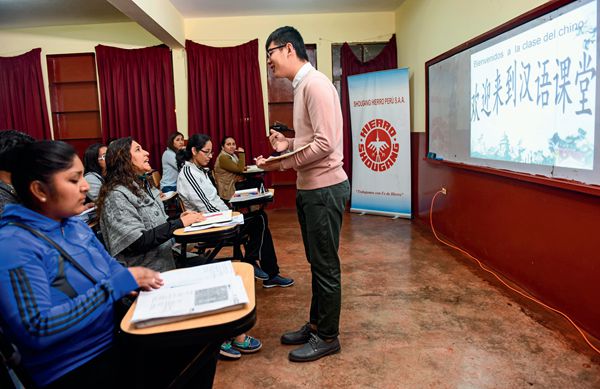By WU HONGYING
By WU HONGYING
CHINESE President Xi Jinping paid a state visit from November 17 to 23, 2016, to three Latin American states: Ecuador, Peru, and Chile. He also attended the 24th APEC Economic Leaders’ Meeting in Lima, Peru. The trip was regarded as a milestone in the history of China-Latin America relations, one that opened a new era of bilateral ties.
Magnificent Diplomatic Event
Challenged by the continuing international financial crisis and sluggish world economy, and facing an immense challenge from severe air and environmental pollution during the process of industrialization, China’s economy has entered the “new normal stage.” The country’s focus in this decisive period of comprehensively deepening reform and building a moderately prosperous society is now on “structural readjustment, steady growth, and innovation-driven development.”
Latin America, meanwhile, is experiencing lackluster social and economic development due to the recession in Europe and the U.S. and relentlessly falling prices of international bulk commodities. With economic growth having shrunk for six consecutive years and achieving an abysmal -0.6 percent of GDP in 2016, it is the universal wish of all Latin American countries to reverse their economic decline by “boarding the China express.”

A ceremony for the launch of the National ICT Talent Development – “Brazil Seeds for the Future,” sponsored by Huawei Branch Office in Brazil – was held at the Trans-America Expo Center in Sao Paulo on October 18, 2016.
China-Latin America trade growth has also fallen in recent years, bilateral trade volume having decreased from US $263.5 billion in 2014 to US $236.5 billion in 2015. Cooperating to bolster both economies under the new circumstances, therefore, constitutes a common challenge.
President Xi’s latest visit to Latin America marked his third including trips in 2013 and 2014. It thus underlined the great importance the Chinese government attaches to Latin America, and also its aspiration to build a win-win relationship.
During Xi’s seven-day visit, he had wide contact with leaders from various nations and people in all communities. He participated in 70-plus diplomatic events, and witnessed the signing of more than 40 cooperative agreements and program contracts. These fruitful achievements attracted worldwide attention, and were universally recognized as a drive to boost Asia-Pacific cooperation and China-Latin America relations, one that also propels a revival of the world economy and evolution of the global landscape.
As China’s Foreign Minister, Wang Yi, commented, President Xi’s visit linked the Chinese Dream with the Latin American Dream and also the Asia-Pacific Dream on the world blueprint for building a shared community of human destiny, so ushering in a new chapter of all-around diplomacy.
Promoting Strategic Cooperation
Since 1993 China has steadily established strategic cooperative partnerships with nine Latin American nations: Brazil, Mexico, Argentina, Venezuela, Peru, Chile, Ecuador, Costa Rica, and Uruguay. Since entering the new century, China has elevated its relations with Brazil, Mexico, Argentina, Venezuela, and Peru to that of “comprehensive strategic cooperative partnership.”

Chinese President Xi Jinping meets Peruvian President Pedro Pablo Kuczynski in Lima on November 21, 2016.
During President Xi’s latest visit, China signed the Joint Announcement on the Establishment of a Comprehensive Strategic Partnership respectively with Ecuador and Chile. Seven countries among the nine former partnerships have thus been promoted to the level of comprehensive strategic cooperative partnership.
China and Peru upgraded their strategic partnership of 2008 to a comprehensive strategic partnership in 2013. During his stay in Lima, President Xi and his Peruvian counterpart Pedro Pablo Kuczynski announced the 2016-2021 Joint Action Initiative, further deepening bilateral relations. So far, China has six strategic cooperative partners in South America, initiatively forming a new landscape of China-Latin America ties. President Xi’s three visits in the space of four years highlights the great importance the Chinese government attaches to Latin America, and the growing demand for strategic cooperation between the two sides.
Upgrading FTAs to Bolster Growth
As of 2015, China had signed free trade agreements (FTAs) with three Latin American countries: Chile in 2005, Peru in 2009, and Costa Rica in 2010. Since then, this bilateral trading has traveled express, with China-Chile bilateral trade volumes increasing five-fold in the 10 years since their FTA came into effect. China-Peru trade volumes also doubled during the six years since their FTA was signed. However, these two FTAs do not cover all commodities, investments, and services.
President Xi and leaders from Peru and Chile have accordingly launched negotiations on the upgrading of the FTA, with the aim of accelerating bilateral trade growth and invigorating potential economic and commercial cooperation.
Advancing Pragmatic Economic Cooperation
A total of 40 or more cooperative agreements and program contracts were signed during President Xi’s visits to Ecuador, Peru, and Chile, covering the diverse areas of mining, energy, manufacturing, agriculture, fishing, communication, and infrastructure.
All these achievements will boost pragmatic economic and trade cooperation, bolster confidence in Latin America’s economy, and promote China-Latin America relations, thereby achieving a win-win situation of mutual development. “Made in China,” “China’s Engineering,” and “China’s Speed” will enable all Latin Americans to feel, experience and, participate in the development of their native countries through elevated cooperation with China.
China’s Latin America Policy for a New Era
President Xi delivered a speech to the Peruvian Congress entitled “Ushering in the Bright Future for China and Latin America,” expounding on China’s policies in Latin America. Xi reiterated in his speech that China will unswervingly support Latin American nations’ discovery of their particular development path in line with their national conditions, support the self-reliance and rejuvenation of Latin America, and give full play to Latin America in international and regional issues.
Xi also proposed boosting new growth through trade, investment, financial cooperation, industrial integration, and innovation. “The community of common destiny shared by China and Latin America” expresses the great aspiration to make China-Latin America cooperation the new model of South-South Cooperation.
In the coming five years, China’s import volumes are predicted to reach US $8 trillion, with utilized foreign capitals of US $600 billion, and its total foreign investment to reach US $750 billion. It will also be the source of 700 million outbound tourists. China will thus provide a wider market, ample capital, abundant products, and precious opportunities to the world as a whole, including Latin American countries. Xi’s speech thus not only showed the orientation of future China-Latin America cooperation, but also set down a blueprint for it.

Since October 2016, Chinese company Shougang Hierro Peru has offered free Chinese lessons for Chilean staff members and local citizens at the site of its mine in the Marcona District of Peru.
Furthermore, to highlight the important role of Xi’s speech in high-level exchanges, on November 24, the day of President Xi’s return from Latin America to Beijing, the Chinese government published a second white paper on Latin America and Caribbean areas – an additional policy document after an initial white paper in 2008.
The document gives a comprehensive explanation of China’s new objectives, proposals, and measures with respect to Latin America policy in the new circumstances. It proposes construction of a new pattern of China-Latin America relations based on sincere mutual political trust, win-win cooperation in economy and trade, collaboration on international affairs, mutual learning in cultural exchanges, and mutual promotion through comprehensive cooperation and bilateral relations – all contributing to build a community of common destiny.
The white paper also advises cooperation in nine areas, including politics, economy and trade, society, international collaboration, peace maintenance, safety guarantees, judiciary, and overall cooperation. The document, representing the high regard in which the Chinese government holds towards Latin America and their bilateral relations, aims to lead the China-Latin America comprehensive cooperative partnership towards a new stage, and to act as guidelines for China-Latin America relations in the new era.
China’s Role in Asia-Pacific Region
During the APEC meeting in Lima, President Xi attended the APEC CEO Summit and delivered a keynote speech that expounded the four aspects the Asia-Pacific Region should promote – an open and integrated economy, interconnectivity, reform and innovation, and win-win cooperation.
At the APEC Economic Leaders’ Meeting, President Xi delivered a keynote speech entitled “Forge Ahead into the Future for Progress and Prosperity in the Asia-Pacific.” In the speech he stressed that China would stay committed to taking economic globalization forward, increasing openness in the Asia-Pacific economy, breaking bottlenecks in regional connectivity, and blazing new trails in reform and innovation.
His new proposals indeed constituted China’s announcement to the world that it will strongly oppose protectionism in all forms, proactively promote and facilitate trade and investment in boundless areas; and unswervingly sustain world commerce and trade, as well as the globalization process.
President Xi appealed to all APEC members to transform consensus into actions and realize the Free Trade Area of the Asia-Pacific (FTAAP) at an early date. Guided by the Chinese government, the 24th APEC Economic Leaders’ Meeting approved the report on Asia-Pacific free trade area collective strategic studies, and agreed on the Lima Declaration on FTAAP.
The two documents set objectives and principles for the establishment of the FTAAP and mapped out possible paths. They also formulated action initiatives in various areas and established the progress reporting mechanism, so making breakthroughs in the establishment of the FTAAP. President Xi’s series of proposals are seen as a follow-up to the outcomes of the 2014 APEC meeting in Beijing and the 2016 G20 Summit in Hangzhou. “China’s Proposals” and “China’s Plans” – which contribute to the Asia-Pacific areas and beyond – received worldwide applause by virtue of China’s impact on global affairs. China is clearly not just a participant and builder in the Asia-Pacific region, but also a campaigner and leader of regional cooperation.
WU HONGYING is the director of the Institute for Latin American Studies at China Institute of Contemporary International Relations (CICIR).
Perceiving China, Memorizing Hangzhou – My Story in Hangzhou